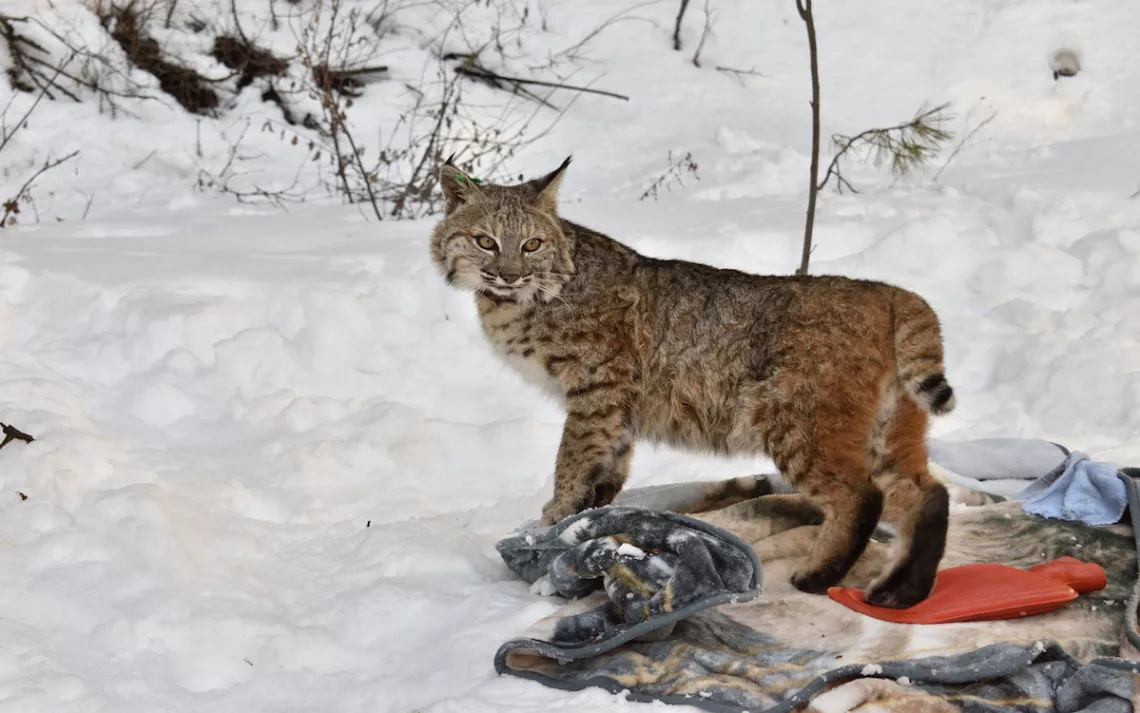Out of the Frying Pan, Onto the Farm
Mid-size predators avoid big carnivores by hiding behind humans—and die for it

Photo courtesy of Prugh Lab, University of Washington
Sometimes the lesser of two evils is a lie—at least it can be for mid-size predators like coyotes and bobcats looking for safety.
When coyotes and bobcats want to avoid large carnivores, they often head toward human settlement, where they end up dead three times more often than mesopredators who stick to the wilderness, according to a new study published in Science. The findings suggest that as wolves return to more parts of the western United States and cougar populations increase, they might end up having big ecosystem effects not just where they live but where they don’t.
Laura Prugh, a wildlife ecologist at the University of Washington in Seattle, and her colleagues collared deer and elk to see how their movements might change as wolves recolonized parts of Washington State. “I thought this was a great opportunity to look at how larger carnivores affect smaller carnivores,” she said. Prugh and her colleagues collared 35 coyotes and 37 bobcats in northern Washington, comparing their movements to 22 collared wolves and 60 collared cougars. They followed the animals’ movements over five years. They also tracked if and how the coyotes and bobcats died.
Both wolves and cougars strongly avoided areas with lots of people. When the wolves and cougars were absent, coyotes and bobcats did too. But when the big carnivores were present, coyotes steered well clear of areas used by the wolves. In Alaska, away from human presence, Prugh noted, wolves often kill coyotes. “It makes sense; wolves are definitely a real threat to them,” she said. They also avoided areas with lots of mountain lion use. Bobcats were slightly less wary of cougars and wolves—possibly because they favor forest just like cougars do. But in both cases, their avoidance meant that bobcats and coyotes shifted their use to more human-impacted areas when wolves and cougars were around. The areas weren’t suburbs or cities. They were “ranch land, farmland, maybe some small towns, more logging activity, just a greater human presence,” Prugh said. But the big carnivores still avoided it, making the humans a shield for the smaller animals.
The choice had a consequence. Over the five years of the study, cougars took out two bobcats and three coyotes. Wolves killed neither. Humans, on the other hand, ended up killing 11 bobcats and 14 coyotes—most of them trapped or shot. The mesopredators were three times more likely to wind up dead from humans than from bigger carnivores.
Geography could have had an impact on the study’s results, noted Christopher J. Schell, an urban ecologist at the University of California, Berkeley, who was not involved in the study. Not all human areas are created equal, he said. In that part of Washington State, “folks have large expanses of land that likely have livestock,” he explained. “When they see those carnivores, they shoot them on sight.” It would be interesting, he said, to see if there are similar effects in other areas, and whether people on tribal lands, for example, might be more tolerant.
Apparently not. Some of the animals were on the lands of the Spokane Tribe of Indians, notes Prugh’s collaborator Savanah Walker, a wildlife biologist with the Spokane Tribe. “The mortality risk to all predators would be similar to the surrounding rural areas,” she said.
The increased deaths might also not be impacting the populations of those animals, said Roland Kays, an ecologist at North Carolina State University in Raleigh who was also not involved in the study. We know the mesopredators are going toward humans and they’re dying, he said, but that doesn’t mean their numbers are decreasing. The human-provided opportunities of food, for example, might mean the animals reproduce enough to succeed anyway.
The results show the impact of carnivores on more than just their typical prey, Schell said, as they navigate living in decreasing human-free zones. “The paper does a good job of centering this notion that these apex predators are taking up the space they need,” he noted, which ends up leaving the mesopredators “between the figurative rock and hard place.”
It’s possible, Prugh noted, that the effect would go the opposite way if the coyotes shifted toward wolves to avoid humans. “But I think they just maybe didn't recognize humans as being such a strong threat as well,” she said. “And so then they ended up getting in trouble.” Coyotes and bobcats can’t smell or see the rifle aimed in their direction several hundred yards away or spot the traps laid. But she’s not too worried about coyotes as a species. In places where mesopredators are at exceptionally high levels because of lack of large carnivores, “reducing their numbers actually can be a good thing.” And she knows nothing will keep a good mesopredator down for long. Coyotes especially “do very well in the face of human persecution and change,” she said. “They are winners.”
 The Magazine of The Sierra Club
The Magazine of The Sierra Club



